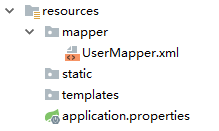Spring Boot2 系列教程(二十一)整合 MyBatis
前面两篇文章和读者聊了 Spring Boot 中最简单的数据持久化方案 JdbcTemplate,JdbcTemplate 虽然简单,但是用的并不多,因为它没有 MyBatis 方便,在 Spring+SpringMVC 中整合 MyBatis 步骤还是有点复杂的,要配置多个 Bean,Spring Boot 中对此做了进一步的简化,使 MyBatis 基本上可以做到开箱即用,本文就来看看在 Spring Boot 中 MyBatis 要如何使用。
工程创建
首先创建一个基本的 Spring Boot 工程,添加 Web 依赖,MyBatis 依赖以及 MySQL 驱动依赖,如下:

创建成功后,添加Druid依赖,并且锁定MySQL驱动版本,完整的依赖如下:
<dependency>
<groupId>org.springframework.boot</groupId>
<artifactId>spring-boot-starter-web</artifactId>
</dependency>
<dependency>
<groupId>org.mybatis.spring.boot</groupId>
<artifactId>mybatis-spring-boot-starter</artifactId>
<version>2.0.0</version>
</dependency>
<dependency>
<groupId>com.alibaba</groupId>
<artifactId>druid-spring-boot-starter</artifactId>
<version>1.1.10</version>
</dependency>
<dependency>
<groupId>mysql</groupId>
<artifactId>mysql-connector-java</artifactId>
<version>5.1.28</version>
<scope>runtime</scope>
</dependency>
如此,工程就算是创建成功了。小伙伴们注意,MyBatis 和 Druid 依赖的命名和其他库的命名不太一样,是属于 xxx-spring-boot-stater 模式的,这表示该 starter 是由第三方提供的。
基本用法
MyBatis 的使用和 JdbcTemplate 基本一致,首先也是在 application.properties 中配置数据库的基本信息:
spring.datasource.url=jdbc:mysql:///test01?useUnicode=true&characterEncoding=utf-8
spring.datasource.username=root
spring.datasource.password=root
spring.datasource.type=com.alibaba.druid.pool.DruidDataSource
配置完成后,MyBatis 就可以创建 Mapper 来使用了,例如我这里直接创建一个 UserMapper2,如下:
public interface UserMapper2 {
@Select("select * from user")
List<User> getAllUsers();
@Results({
@Result(property = "id", column = "id"),
@Result(property = "username", column = "u"),
@Result(property = "address", column = "a")
})
@Select("select username as u,address as a,id as id from user where id=#{id}")
User getUserById(Long id);
@Select("select * from user where username like concat('%',#{name},'%')")
List<User> getUsersByName(String name);
@Insert({"insert into user(username,address) values(#{username},#{address})"})
@SelectKey(statement = "select last_insert_id()", keyProperty = "id", before = false, resultType = Integer.class)
Integer addUser(User user);
@Update("update user set username=#{username},address=#{address} where id=#{id}")
Integer updateUserById(User user);
@Delete("delete from user where id=#{id}")
Integer deleteUserById(Integer id);
}
这里是通过全注解的方式来写 SQL,不写 XML 文件。
@Select、@Insert、@Update 以及 @Delete 四个注解分别对应 XML 中的 select、insert、update 以及 delete 标签,@Results 注解类似于 XML 中的 ResultMap 映射文件(getUserById 方法给查询结果的字段取别名主要是向小伙伴们演示下 @Results 注解的用法)。
另外使用 @SelectKey 注解可以实现主键回填的功能,即当数据插入成功后,插入成功的数据 id 会赋值到 user 对象的id 属性上。
UserMapper2 创建好之后,还要配置 mapper 扫描,有两种方式,一种是直接在 UserMapper2 上面添加 @Mapper 注解,这种方式有一个弊端就是所有的 Mapper 都要手动添加,要是落下一个就会报错,还有一个一劳永逸的办法就是直接在启动类上添加 Mapper 扫描,如下:
@SpringBootApplication
@MapperScan(basePackages = "org.javaboy.mybatis.mapper")
public class MybatisApplication {
public static void main(String[] args) {
SpringApplication.run(MybatisApplication.class, args);
}
}
好了,做完这些工作就可以去测试 Mapper 的使用了。
mapper 映射
当然,开发者也可以在 XML 中写 SQL,例如创建一个 UserMapper,如下:
public interface UserMapper {
List<User> getAllUser();
Integer addUser(User user);
Integer updateUserById(User user);
Integer deleteUserById(Integer id);
}
然后创建 UserMapper.xml 文件,如下:
<?xml version="1.0" encoding="UTF-8" ?>
<!DOCTYPE mapper
PUBLIC "-//mybatis.org//DTD Mapper 3.0//EN"
"http://mybatis.org/dtd/mybatis-21-mapper.dtd">
<mapper namespace="org.javaboy.mybatis.mapper.UserMapper">
<select id="getAllUser" resultType="org.javaboy.mybatis.model.User">
select * from t_user;
</select>
<insert id="addUser" parameterType="org.javaboy.mybatis.model.User">
insert into user (username,address) values (#{username},#{address});
</insert>
<update id="updateUserById" parameterType="org.javaboy.mybatis.model.User">
update user set username=#{username},address=#{address} where id=#{id}
</update>
<delete id="deleteUserById">
delete from user where id=#{id}
</delete>
</mapper>
将接口中方法对应的 SQL 直接写在 XML 文件中。
那么这个 UserMapper.xml 到底放在哪里呢?有两个位置可以放,第一个是直接放在 UserMapper 所在的包下面:

放在这里的 UserMapper.xml 会被自动扫描到,但是有另外一个 Maven 带来的问题,就是 java 目录下的 xml 资源在项目打包时会被忽略掉,所以,如果 UserMapper.xml 放在包下,需要在 pom.xml 文件中再添加如下配置,避免打包时 java 目录下的 XML 文件被自动忽略掉:
<build>
<resources>
<resource>
<directory>src/main/java</directory>
<includes>
<include>**/*.xml</include>
</includes>
</resource>
<resource>
<directory>src/main/resources</directory>
</resource>
</resources>
</build>
当然,UserMapper.xml 也可以直接放在 resources 目录下,这样就不用担心打包时被忽略了,但是放在 resources 目录下,必须创建和 Mapper 接口包目录相同的目录层级,这样才能确保打包后 XML 和 Mapper 接口又处于在一起,否则 XML 文件将不能被自动扫描,这个时候就需要添加额外配置。例如我在 resources 目录下创建 mapper 目录用来放 mapper 文件,如下:

此时在 application.properties 中告诉 mybatis 去哪里扫描 mapper:
mybatis.mapper-locations=classpath:mapper/*.xml
如此配置之后,mapper 就可以正常使用了。注意这种方式不需要在 pom.xml 文件中配置文件过滤。
原理分析
在 SSM 整合中,开发者需要自己提供两个 Bean,一个SqlSessionFactoryBean ,还有一个是 MapperScannerConfigurer,在 Spring Boot 中,这两个东西虽然不用开发者自己提供了,但是并不意味着这两个 Bean 不需要了,在 org.mybatis.spring.boot.autoconfigure.MybatisAutoConfiguration 类中,我们可以看到 Spring Boot 提供了这两个 Bean,部分源码如下:
@org.springframework.context.annotation.Configuration
@ConditionalOnClass({ SqlSessionFactory.class, SqlSessionFactoryBean.class })
@ConditionalOnSingleCandidate(DataSource.class)
@EnableConfigurationProperties(MybatisProperties.class)
@AutoConfigureAfter(DataSourceAutoConfiguration.class)
public class MybatisAutoConfiguration implements InitializingBean {
@Bean
@ConditionalOnMissingBean
public SqlSessionFactory sqlSessionFactory(DataSource dataSource) throws Exception {
SqlSessionFactoryBean factory = new SqlSessionFactoryBean();
factory.setDataSource(dataSource);
return factory.getObject();
}
@Bean
@ConditionalOnMissingBean
public SqlSessionTemplate sqlSessionTemplate(SqlSessionFactory sqlSessionFactory) {
ExecutorType executorType = this.properties.getExecutorType();
if (executorType != null) {
return new SqlSessionTemplate(sqlSessionFactory, executorType);
} else {
return new SqlSessionTemplate(sqlSessionFactory);
}
}
@org.springframework.context.annotation.Configuration
@Import({ AutoConfiguredMapperScannerRegistrar.class })
@ConditionalOnMissingBean(MapperFactoryBean.class)
public static class MapperScannerRegistrarNotFoundConfiguration implements InitializingBean {
@Override
public void afterPropertiesSet() {
logger.debug("No {} found.", MapperFactoryBean.class.getName());
}
}
}
从类上的注解可以看出,当当前类路径下存在 SqlSessionFactory、 SqlSessionFactoryBean 以及 DataSource 时,这里的配置才会生效,SqlSessionFactory 和 SqlTemplate 都被提供了。为什么要看这段代码呢?下篇文章,松哥和大伙分享 Spring Boot 中 MyBatis 多数据源的配置时,这里将是一个重要的参考。
好了,本文就先说到这里,本文相关案例,大家可以在 GitHub 上下载:https://github.com/lenve/javaboy-code-samples
关注公众号【江南一点雨】,专注于 Spring Boot+微服务以及前后端分离等全栈技术,定期视频教程分享,关注后回复 Java ,领取松哥为你精心准备的 Java 干货!

Spring Boot2 系列教程(二十一)整合 MyBatis的更多相关文章
- Spring Boot2 系列教程 (九) | SpringBoot 整合 Mybatis
前言 如题,今天介绍 SpringBoot 与 Mybatis 的整合以及 Mybatis 的使用,本文通过注解的形式实现. 什么是 Mybatis MyBatis 是支持定制化 SQL.存储过程以及 ...
- Spring Boot2 系列教程(二十)Spring Boot 整合JdbcTemplate 多数据源
多数据源配置也算是一个常见的开发需求,Spring 和 SpringBoot 中,对此都有相应的解决方案,不过一般来说,如果有多数据源的需求,我还是建议首选分布式数据库中间件 MyCat 去解决相关问 ...
- Spring Boot2 系列教程(二十五)Spring Boot 整合 Jpa 多数据源
本文是 Spring Boot 整合数据持久化方案的最后一篇,主要和大伙来聊聊 Spring Boot 整合 Jpa 多数据源问题.在 Spring Boot 整合JbdcTemplate 多数据源. ...
- Spring Boot2 系列教程(二十六)Spring Boot 整合 Redis
在 Redis 出现之前,我们的缓存框架各种各样,有了 Redis ,缓存方案基本上都统一了,关于 Redis,松哥之前有一个系列教程,尚不了解 Redis 的小伙伴可以参考这个教程: Redis 教 ...
- Spring Boot2 系列教程(二十八)Spring Boot 整合 Session 共享
这篇文章是松哥的原创,但是在第一次发布的时候,忘了标记原创,结果被好多号转发,导致我后来整理的时候自己没法标记原创了.写了几百篇原创技术干货了,有一两篇忘记标记原创进而造成的一点点小小损失也能接受,不 ...
- Spring Boot2 系列教程(二)创建 Spring Boot 项目的三种方式
我最早是 2016 年底开始写 Spring Boot 相关的博客,当时使用的版本还是 1.4.x ,文章发表在 CSDN 上,阅读量最大的一篇有 43W+,如下图: 2017 年由于种种原因,就没有 ...
- Spring Boot2 系列教程(二十二)整合 MyBatis 多数据源
关于多数据源的配置,前面和大伙介绍过 JdbcTemplate 多数据源配置,那个比较简单,本文来和大伙说说 MyBatis 多数据源的配置. 其实关于多数据源,我的态度还是和之前一样,复杂的就直接上 ...
- Spring Boot2 系列教程(二十四)Spring Boot 整合 Jpa
Spring Boot 中的数据持久化方案前面给大伙介绍了两种了,一个是 JdbcTemplate,还有一个 MyBatis,JdbcTemplate 配置简单,使用也简单,但是功能也非常有限,MyB ...
- Spring Boot2 系列教程(二十九)Spring Boot 整合 Redis
经过 Spring Boot 的整合封装与自动化配置,在 Spring Boot 中整合Redis 已经变得非常容易了,开发者只需要引入 Spring Data Redis 依赖,然后简单配下 red ...
随机推荐
- Ubuntu server 安装及jdk+mysql安装教程
Ubuntu server 安装教程 1.查找及下载Ubuntu镜像文件 可以在以下页面下载想要的版本,我这里选择19.04 server版的iso镜像文件: http://mirrors.163.c ...
- 未来实现API管理系统的几个关键词
下面将通过几个关键词的形式说明API管理的重要性和未来的实现方式. 1.生命周期管理 在整个API生命周期中更深入地集成所有工具将进一步提高生命周期循环的速度,而且更重要的是提供满足消费者需求的API ...
- 原生js动态添加新元素、删除元素方法
1. 添加新元素 <!DOCTYPE html> <html> <head> <meta charset="utf-8"> < ...
- java并发之CAS详解
前言 在高并发的应用当中,最关键的问题就是对共享变量的安全访问,通常我们都是通过加锁的方式,比如说synchronized.Lock来保证原子性,或者在某些应用当中,用voliate来保证变量的可见性 ...
- 声学回声消除(Acoustic Echo Cancellation)
回声就是声音信号经过一系列反射之后,又听到了自己讲话的声音,这就是回声.一些回声是必要的,比如剧院里的音乐回声以及延迟时间较短的房间回声:而大多数回声会造成负面影响,比如在有线或者无线通信时重复听到自 ...
- JAVA中JDK开发环搭的搭建,jvm jre
1.JDK的下载与安装: www.oracle.com 安装需要注意的是:不能把jdk安装到有空格或中文的文件夹中,建议大家在某个目录下创建一个JavaWeb的文件夹,然后把所学的java所有内容(后 ...
- 代码审计-dedecms任意文件名修改拿shell
0x01 漏洞分析 漏洞文件: dede/file_manage_control.php ,$fmdo 开始时赋值,所以我们可以使fmdo=rename ,使其进入 if语句 ,调用 FileMana ...
- windows进程中的内存结构(缓冲溢出原理)
接触过编程的人都知道,高级语言都能通过变量名来访问内存中的数据.那么这些变量在内存中是如何存放的呢?程序又是如何使用这些变量的呢?下面就会对此进行深入的讨论.下文中的C语言代码如没有特别声明,默认都使 ...
- JVM 中发生内存溢出的 8 种原因及解决办法
1. Java 堆空间 2. GC 开销超过限制 3. 请求的数组大小超过虚拟机限制 4. Perm gen 空间 5. Metaspace 6. 无法新建本机线程 7. 杀死进程或子进程 8. 发生 ...
- Python开发【第三篇】数据类型
1.数字类型 int 整数 1 2 3 float 浮点数 1.1 0.9 0.99 complex 复数 (2+0j) str 字符串 'hello world' "hello world ...
